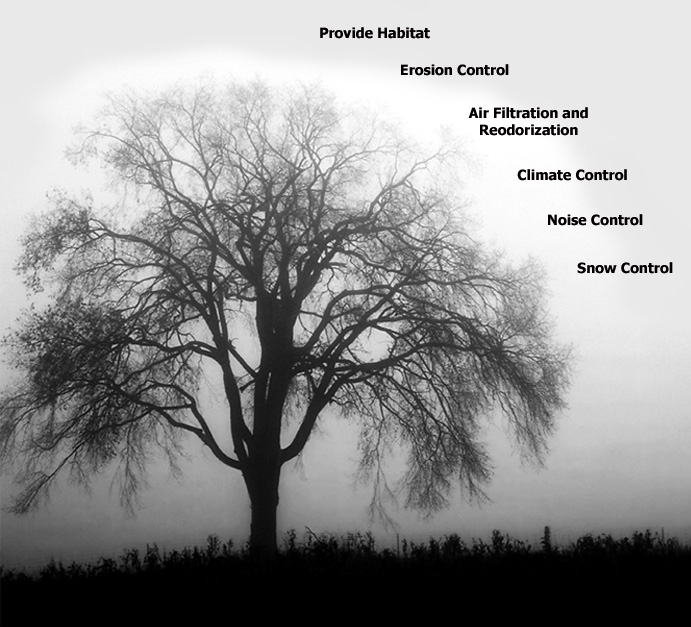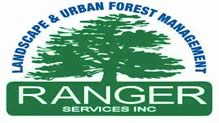
Community Benefits
Trees reduce crime. Apartment buildings with high levels of greenery had 52% fewer crimes than those without any trees. Buildings with medium amounts of greenery had 42% fewer crimes.14
Trees can create lasting impression on how a community is perceived by visitors and affect the mood and community pride of its residents.
People walk and jog more on streets with trees; children and adults have a cool place to play or relax in the summer, thus increasing their interaction with neighbors.
A tree can add music to your life by attracting birds and other animals.
A tree can provide pleasant smells. A cherry tree can perfume the air with 200,000 flowers.
Trees can serve as a living legacy for the next generation - thus linking us to near and distant generations.
Trees can screen unattractive views, soften the sometimes harsh outline of masonry, metal, asphalt, steel, and glass
Trees provide us with color, flowers, fruit, interesting shapes and forms to look at.
Environmental Benefits
Trees along rivers, streams and lakes reduce water temeratuers by their shade, prevent or reduce bank erosion and silt, and provide hiding places for improving fisheries habitat.
Trees reduce runoff by breaking rainfall thus allowing the water to flow down the trunk and into the earth below the tree. This prevents stormwater from carrying pollutants to the ocean. When mulched, trees act like a sponge that filters this water naturally and uses it to recharge groundwater supplies.
Trees help cool the city by up to 10°F, by shading our homes and streets, breaking up urban "heat islands" and releasing water vapor into the air through their leaves.
Shade from trees slows water evaporation from thirsty lawns. Most newly planted trees need only fifteen gallons of water a week. As trees transpire, they increase atmospheric moisture.
Trees along rivers, streams and lakes reduce water temperatures by their shade, prevent or reduce bank erosion and silt, and provide hiding places for improving fisheries habitat.
One acre of forest absorbs six tons of carbon dioxide and puts out four tons of oxygen. This is enough to meet the annual needs of 18 people.8
Economic Benefits
Trees in urban parks and recreation areas are estimated to improve outdoor leisure and recreation experiences in the United States by $2 billion per year.
In some sectors of the economy such as tree care, there is a job for every trained worker, because such companies struggle to find qualified employees.1
Urban forests in the United States contain about 3.8 billion trees, with an estimated structural asset value of $2.4 trillion.5
Green streets, rain barrels, and tree planting are estimated to be 3-6 times more effective in managing stormwater per $1,000 invested than conventional methods.2
The average annual net benefit of a mature large tree is $85 in a yard and $113 on public land.3
Net benefits for a yard and public tree summed over 40-year period:4
o Large Tree: $4,320 (yard) and $3,880 (public)
o Medium Tree: $1,040 (yard) and $760 (public)
o Small Tree: $280 (yard) and $40 (public)
o Conifer: $2,040 (yard) and $1,640 (public)
Home & Business Benefits
Research shows that shoppers in well-landscaped business districts are willing to pay more for parking and up to 12% more for goods and services.
Landscaping, especially with trees, can increase property values as much as 20%.7
In one study, 83% of realtors believe that mature trees have a 'strong or moderate impact' on the salability of homes listed for under $150,000; on homes over $250,000 this perception increases to 98%6
Just 3–4 shade trees located strategically around a house can cut summer cooling costs by 30–50%.1
Apartments and offices in wooded areas rent quicker and have a higher occupancy rate; workers in offices in wooded areas report more productivity and less absenteeism.
A study found 7% higher rental rates for commercial offices having high quality landscapes.
Shoppers will travel further and longer to visit a district with high quality trees, and spend more time there once they arrive.
New tree plantings can increase surrounding housing values by approximately 10%
Health Benefits
Kids in tree-lined neighborhoods play outside 10% more and have lower rates of ADD and asthma.1
Symptoms of Attention Deficit Hyperactivity Disorder (ADHD) in children are relieved after contact with nature. Specifically, ADHD kids are better able to concentrate, complete tasks, and follow directions after playing in natural settings. The greener the setting, the more the relief.13
Hospital patients recovering from surgery who had a view of a grove of trees through their windows required fewer pain relievers, experienced fewer complications, and left the hospital sooner than similar patients who had a view of a brick wall12.
In laboratory research, visual exposure to settings with trees has produced significant recovery from stress within five minutes, as indicated by changes in blood pressure and muscle tension.11
Desk workers with and without views of nature were surveyed. Those without views of nature, when asked about 11 different ailments, claimed 23% more incidence of illness in the prior 6 months.10
Views of nature reduce the stress response of both body and mind when stressors of urban conditions are present.9
sources
2)Foster, Josh, Ashley Lowe, and Steve Winkelman. The Value of Green Infrastructure for Urban Climate Adaptation. Rep. Center for Clean Air Policy, 2011. Web. "http://www.ccap.org/docs/resources/989/Green_Infrastructure_FINAL.pdf".
3) McPherson, Gregory E., James R. Simpson, Paula J. Peper, Shelley L. Gardner, Kelaine E. Vargas, and Qingfu Xiao. Northeast Community Tree Guide: Benefits, Costs, and Strategic Planting. Tech. USDA, Forest Service, Pacific Southwest Research Station, 2007. Web. http://www.fs.fed.us/psw/publications/documents/psw_gtr202/psw_gtr202.pdf
4) McPherson, Gregory, James Simpson, Paula Peper, Shelley Gardner, Kelaine Vargas, Scott Maco, and Qingfu Xiao. “Coastal Plain Community Tree Guide: Benefits, Costs, and Strategic Planting”. USDA, Forest Service, Pacific Southwest Research Station. (2006). Web. http://www.fs.fed.us/psw/programs/uesd/uep/products/2/cufr_679_gtr201_coastal_tree_guide. pdf
5) Nowak, D.J.; Crane, D.E.; Dwyer, J.F. 2002. “Compensatory value of urban trees in the United States.” Journal of Arboriculture. 28(4): 194-199.
6) Arbor National Mortgage & American Forests
7) Management Information Services/ICMA
8) U.S. Department of Agriculture
9)Parsons, R.; Tassinary, L.G.; Ulrich, R.S.; Hebl, M.R.; Grossman-Alexander, M. 1998. The View From the Road: Implications for Stress Recovery and Immunization. Journal of Environmental Psychology 18(2).
10)Kaplan, R.; Kaplan, S. 1989. The Experience of Nature: A Psychological Perspective. Cambridge, MA: Cambridge University Press.
11) Dr Roger S. Ulrich texas A&M University
12) Ulrich, R. 1984. View through Window May Influence Recovery from Surgery 224. Ulrich, R.S. 1985. Human Responses to Vegetation and Landscapes. Landscape and Urban Planning 13.
13) Taylor, A.F.; Kuo, F.; Sullivan,W. 2001. Coping with ADD: The Surprising Connection to Green Play Settings. Environment and Behavior 33(1).
14) Kuo, F.; Sullivan,W. 2001. Environment and Crime in the Inner City: Does Vegetation Reduce Crime? Environment and Behavior 33(3).
